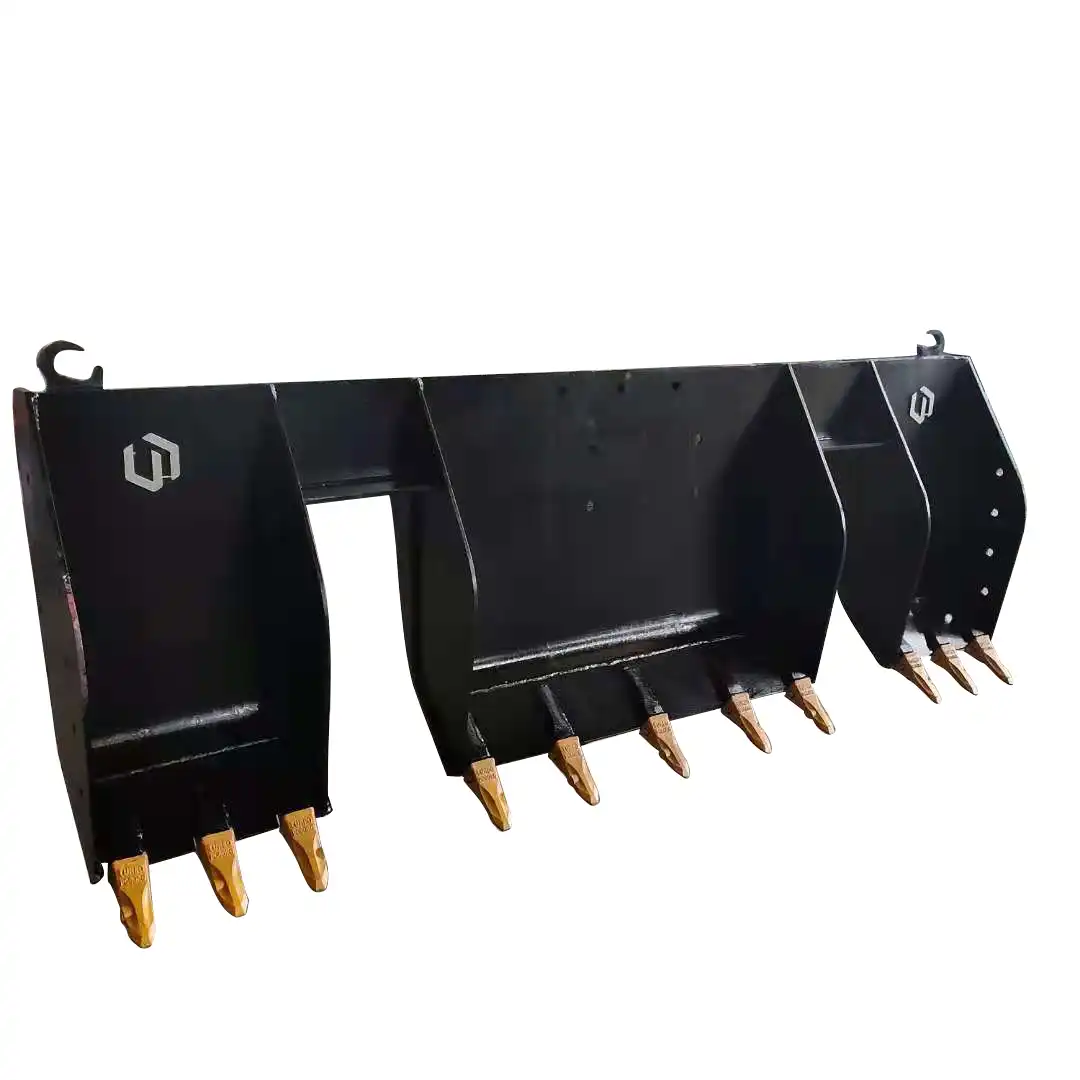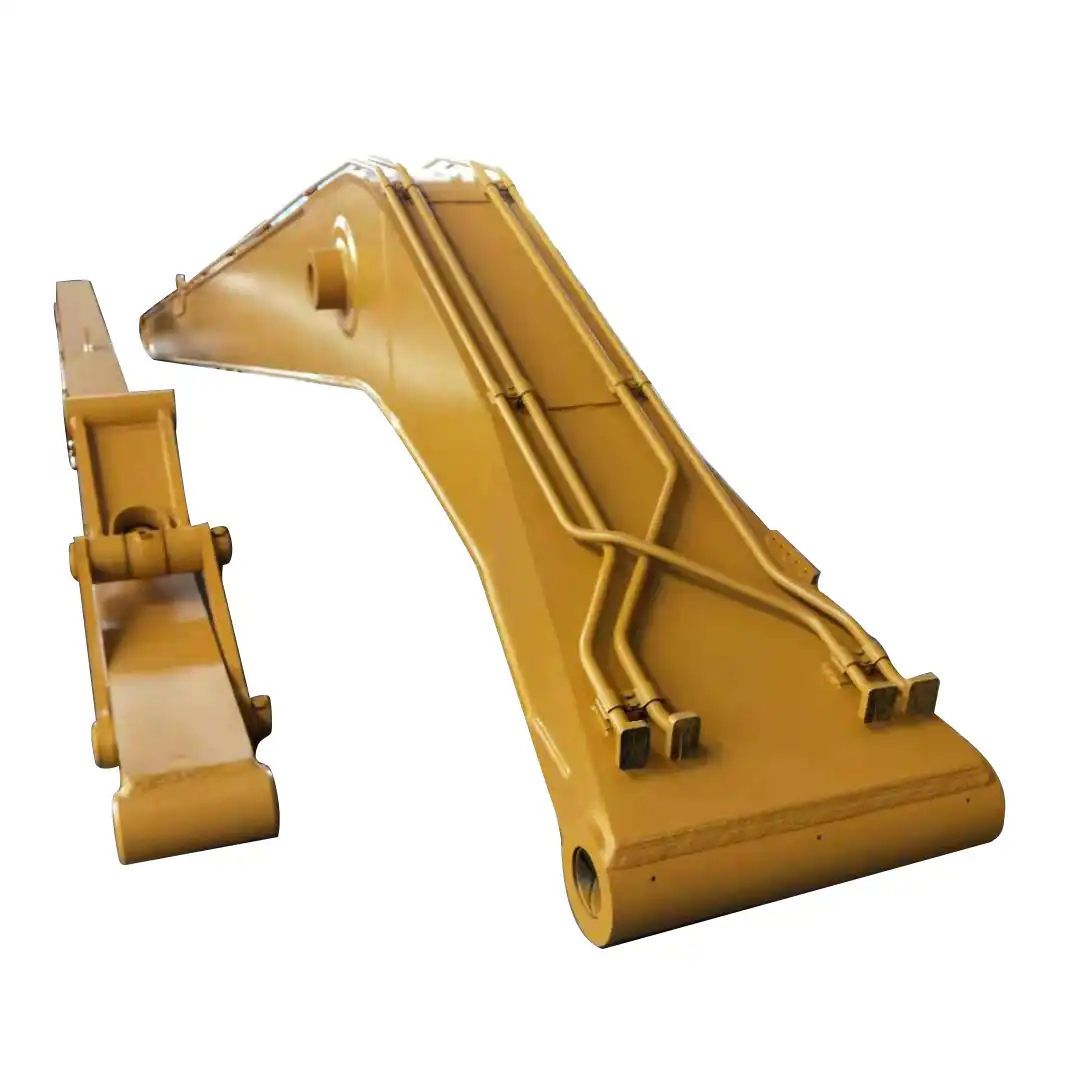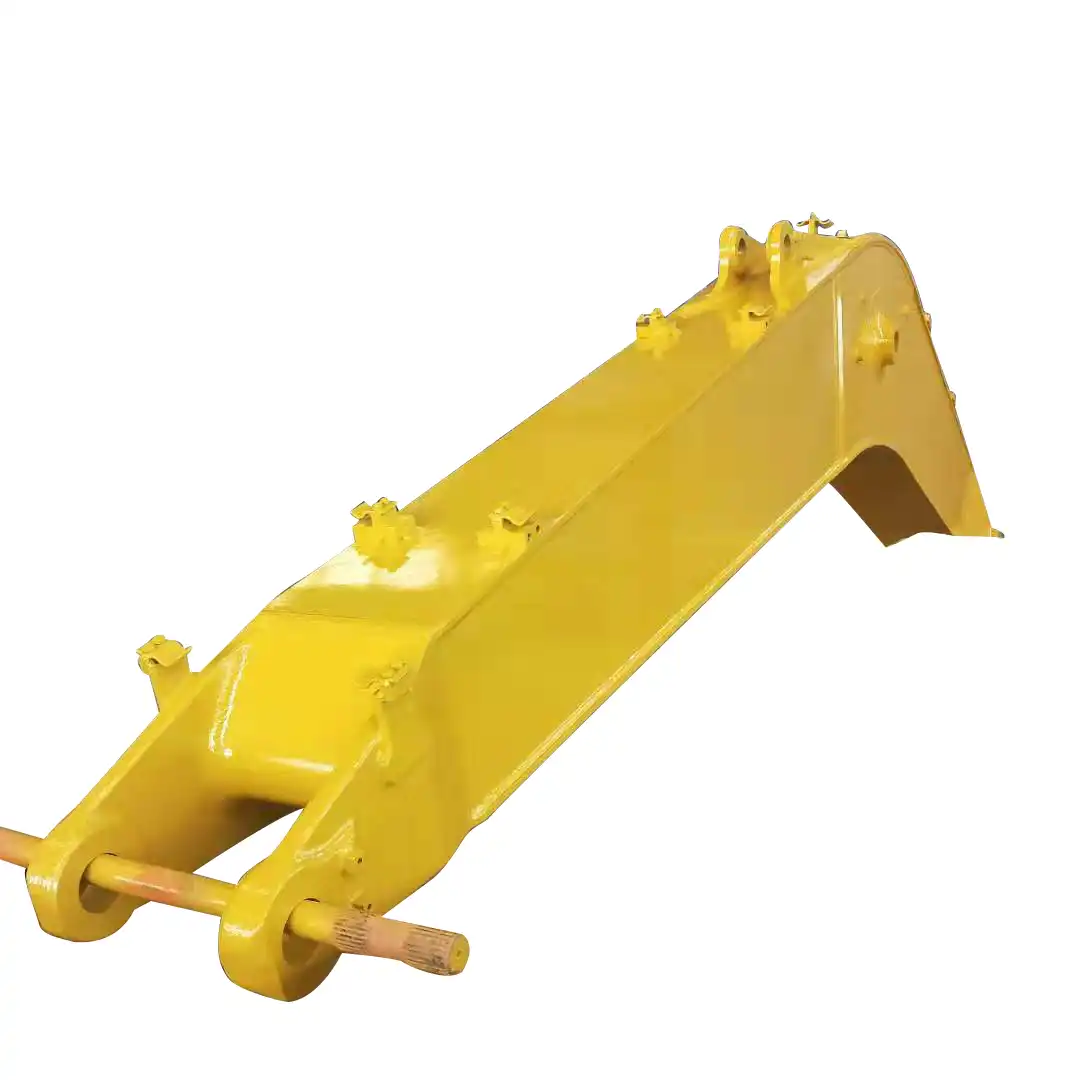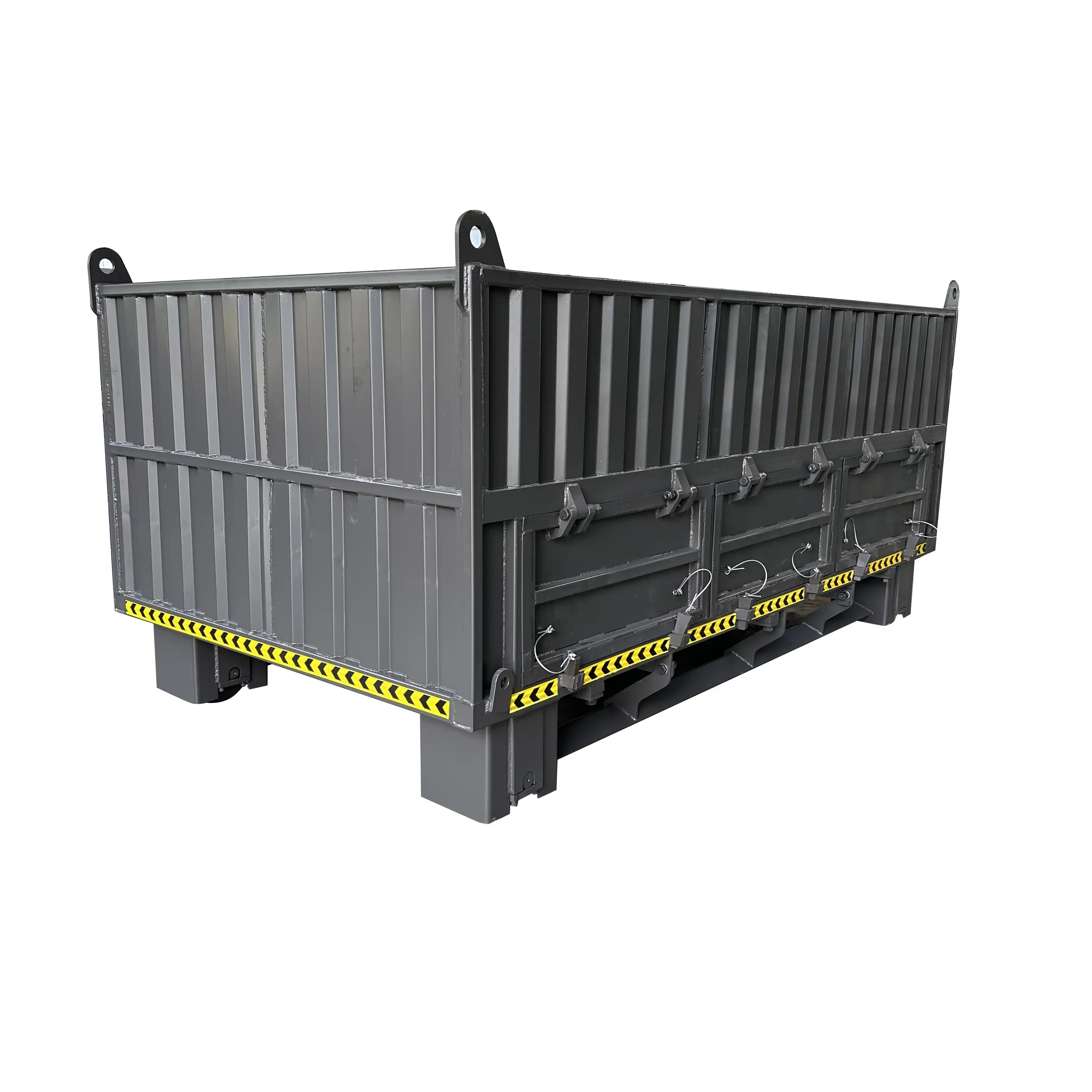What is the standard size excavator boom and arm maximum reach?
Excavators are essential machines in the construction and mining industries, known for their versatility and efficiency in digging, trenching, and material handling. One of the most critical components of an excavator is its boom and arm assembly, which determines the machine's reach and digging capabilities. In this comprehensive guide, we'll explore the standard size excavator boom and arm, focusing on their maximum reach, measurement techniques, and impact on performance.

Understanding the Standard Size Excavator Boom and Arm
The boom and arm of an excavator are the two main components that make up the machine's digging mechanism. The boom is the larger, primary arm that connects to the excavator's body, while the arm (also called the stick) is the secondary component attached to the end of the boom. Together, they form the excavator's reach and determine its digging depth and lifting capacity.
Standard size excavator booms and arms vary depending on the machine's size class and intended applications. Manufacturers typically offer different boom and arm configurations to cater to various job site requirements. The standard size for excavator booms and arms is generally designed to provide a balance between reach, digging depth, and lifting capacity.
For small to medium-sized excavators (2 to 20 tons), the typical boom length ranges from 2.5 to 5.7 meters, while the arm length varies from 1.5 to 3.0 meters. Larger excavators (20 to 90 tons) may have boom lengths ranging from 5.7 to 10 meters and arm lengths from 2.5 to 5 meters. However, these dimensions can vary depending on the manufacturer and specific model.
How is the Maximum Reach of a Standard Excavator Boom and Arm Measured?
The maximum reach of an excavator boom and arm is a crucial specification that determines the machine's working range. This measurement is typically taken from the center of the excavator's swing to the furthest point the bucket can reach when fully extended. The process of measuring the maximum reach involves several steps:
- Positioning the excavator: The machine is placed on a level surface with the tracks or wheels parallel to the measurement line.
- Extending the boom and arm: The boom and arm are fully extended horizontally, with the bucket positioned flat on the ground.
- Measuring the distance: The horizontal distance is measured from the center of the excavator's swing pivot to the tip of the bucket teeth.
- Accounting for attachments: If the excavator is equipped with a quick coupler or other attachments, these are typically included in the reach measurement.
It's important to note that the maximum reach can vary depending on the specific boom and arm configuration, as well as the type of bucket or attachment being used. Manufacturers usually provide detailed reach diagrams that illustrate the working range of their excavators under various conditions [2].
In addition to the horizontal reach, other important measurements include:
- Maximum digging depth: The deepest point the excavator can dig below ground level.
- Maximum dump height: The highest point at which the excavator can discharge material.
- Maximum vertical wall depth: The maximum depth the excavator can dig along a vertical plane.
These measurements collectively provide a comprehensive understanding of the excavator's capabilities and help operators and project managers determine the most suitable machine for specific job requirements.
How Does Boom and Arm Length Affect Excavation Performance?
The length of an excavator boom and arm significantly impacts its performance across various aspects of operation. Understanding these effects is crucial for selecting the right configuration for specific job requirements:
1. Reach and Digging Depth
Longer booms and arms generally provide greater reach and digging depth. This increased range can be beneficial for tasks such as:
- Excavating wide trenches without repositioning the machine
- Reaching across obstacles or over structures
- Digging deeper foundations or utility trenches
However, it's important to note that while longer components increase reach, they may reduce the machine's lifting capacity and stability, especially when fully extended.
2. Lifting Capacity
The length of the boom and arm directly affects the excavator's lifting capacity. Shorter booms and arms typically offer higher lifting capacities because:
- The load is closer to the machine's center of gravity
- There's less leverage working against the hydraulic system
- The overall weight of the boom and arm assembly is reduced
For heavy lifting tasks or when working with dense materials, a configuration with a shorter boom and arm may be more suitable.
3. Maneuverability and Working in Confined Spaces
Excavators with shorter booms and arms are generally more maneuverable and better suited for working in tight spaces. This configuration allows for:
- Easier operation in urban environments or congested job sites
- More precise digging and material handling in confined areas
- Reduced risk of collisions with nearby structures or obstacles
Longer configurations, while offering extended reach, may be more challenging to operate in restricted spaces.
4. Digging Force
The length of the boom and arm affects the excavator's digging force. Generally:
- Shorter arms provide greater digging force at the bucket
- Longer arms reduce the available digging force due to increased leverage
For applications requiring high breakout forces, such as excavating compacted soil or rock, a shorter arm configuration may be more effective.
5. Fuel Efficiency
The boom and arm configuration can impact fuel consumption:
- Longer booms and arms may require more hydraulic power to operate, potentially increasing fuel consumption
- Shorter configurations generally offer better fuel efficiency, especially during repetitive digging cycles
However, the overall impact on fuel efficiency depends on various factors, including the specific task, operator skill, and machine design.
6. Versatility
Different boom and arm lengths offer varying degrees of versatility:
- Standard configurations provide a balance of reach, digging depth, and lifting capacity suitable for a wide range of applications
- Specialized long-reach configurations excel in specific tasks like dredging or slope finishing but may be less versatile for general excavation work
Choosing the right configuration depends on the primary tasks the excavator will perform and the job site conditions.
Can the Maximum Reach be Extended with Modifications?
While standard size excavator booms and arms are designed to meet a wide range of applications, there are situations where extending the maximum reach is necessary. Several options are available to modify an excavator's reach capabilities:
1. Long Reach Configurations
Many manufacturers offer long reach boom and arm configurations as factory options or aftermarket modifications. These specialized setups typically include:
- Extended boom and arm components
- Reinforced structures to handle the increased stress
- Modified hydraulic systems to accommodate the longer reach
Long reach configurations can significantly increase the excavator's maximum reach, sometimes doubling the standard reach. However, they often come with reduced lifting capacity and may require additional counterweights.
2. Telescopic Booms
Some excavators are equipped with telescopic booms that can extend and retract, providing:
- Increased reach when needed
- Improved maneuverability in confined spaces when retracted
- Greater versatility for various job site requirements
Telescopic booms are particularly useful in applications where both extended reach and compact operation are necessary.
3. Boom Extensions
Aftermarket boom extensions can be added to standard excavator booms to increase reach. These extensions:
- Are typically bolted or pinned to the existing boom
- Provide a cost-effective solution for occasional long-reach requirements
- May require additional hydraulic modifications
It's crucial to ensure that any boom extension is compatible with the excavator's design and does not exceed its structural and hydraulic capabilities.
4. Custom Fabrication
For specialized applications, custom-fabricated booms and arms can be designed to meet specific reach requirements. This approach:
- Allows for tailored solutions to unique job site challenges
- Requires careful engineering to maintain machine stability and performance
- May involve significant costs and lead times
Custom fabrication should only be undertaken by experienced professionals with a thorough understanding of excavator design and safety considerations.
5. Attachments with Extended Reach
In some cases, the effective reach of an excavator can be extended through the use of specialized attachments:
- Long-handled grapples or material handlers
- Hydraulic breakers with extended booms
- Specialized dredging attachments
These attachments can provide additional reach for specific tasks without modifying the excavator's core structure.
Considerations for Extended Reach Modifications
When considering modifications to extend an excavator's reach, it's essential to take into account:
- The impact on machine stability and tipping load
- Potential reductions in lifting capacity and digging force
- Increased stress on hydraulic components and structures
- Compliance with safety regulations and manufacturer guidelines
- The need for operator training to safely handle the modified equipment
Any modifications should be carefully evaluated and implemented by qualified professionals to ensure safe and effective operation.
Tiannuo Standard Size Excavator Boom And Arm
Understanding the intricacies of standard size excavator booms and arms is crucial for optimizing performance and efficiency in construction and earthmoving projects. The maximum reach of these components plays a vital role in determining an excavator's capabilities and suitability for various applications. By considering factors such as measurement techniques, the impact on performance, and potential modifications, operators and project managers can make informed decisions to enhance productivity and safety on the job site.
For those seeking high-quality standard size excavator booms and arms, Tiannuo Machinery stands out as a leading manufacturer and supplier with over 10 years of industry experience.
If you're in the market for reliable and efficient standard size excavator booms and arms, we invite you to explore Tiannuo Machinery's offerings. For more information or to discuss your specific needs, please don't hesitate to contact our team:
- Manager: arm@stnd-machinery.com
- Sales Team: rich@stnd-machinery.com or tn@stnd-machinery.com
Our experienced professionals are ready to assist you in finding the perfect solution for your excavation projects.
References
- Caterpillar Inc. (2021). Excavator Size Classes and Typical Specifications.
- Komatsu Ltd. (2020). Excavator Working Range Measurement Guidelines.
- John Deere Construction & Forestry Division. (2019). Impact of Boom and Arm Configuration on Excavator Performance.
- Volvo Construction Equipment. (2022). Excavator Digging Force and Productivity Analysis.
- Hitachi Construction Machinery Co., Ltd. (2021). Long Reach Excavator Configurations and Applications.









